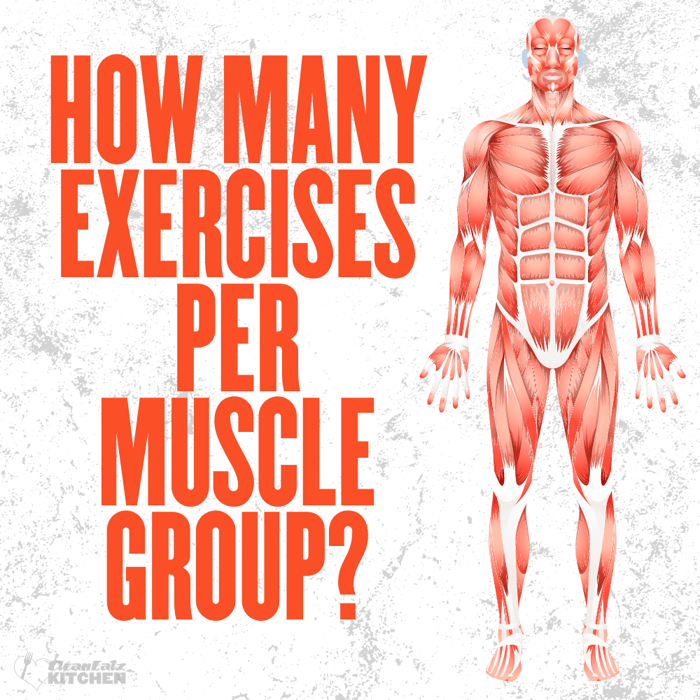Last updated: September 16, 2025
How Many Exercises Per Muscle Group? (Per Workout & Per Week)
Quick answer: Most lifters grow best doing 2–3 exercises per large muscle group (chest, back, quads, hamstrings, glutes) and 1–2 for smaller muscles (biceps, triceps, calves) in a session—about 6–10 hard sets per big muscle and 4–8 for small. Across the week, aim for roughly 10–20 total sets per big muscle and 8–16 for small, split over 2–3 days. Push most sets to RIR 1–3 (1–3 reps in reserve), add reps or load weekly, and cut fluff.
The Basics: Exercises vs Sets (What Actually Drives Growth)
- Sets are the driver of weekly training volume. Exercises are just how you divide those sets.
- Hard sets = sets taken near effort (about RIR 1–3). Junk volume (easy sets, sloppy form) doesn’t move the needle.
- Quality beats quantity: pick a few effective moves, execute well, progress weekly.
Per-Workout Guidelines (By Muscle Size)
| Muscle group | Exercises per session | Sets per session | Notes |
|---|---|---|---|
| Chest, Back, Quads, Hamstrings, Glutes | 2–3 | 6–10 hard sets | One compound + 1–2 accessories covers angles without fluff |
| Shoulders (delts) | 2–3 | 6–10 | Emphasize lateral + rear delts; presses count for front delts |
| Biceps, Triceps, Calves | 1–2 | 4–8 | Many compounds already hit arms; keep isolation crisp |
| Abs/Core | 1–2 | 4–8 | Favor anti-rotation / anti-lateral-flexion for a tighter waist (see waist guide) |
Per-Week Set Targets (Beginner → Advanced)
Spread sets across 2–3 days per muscle when possible. Start low; add sets only if recovery and progress are strong.
| Muscle group | Beginner | Intermediate | Advanced |
|---|---|---|---|
| Chest, Back, Quads, Hamstrings, Glutes | 8–12 sets/wk | 12–18 sets/wk | 14–20+ sets/wk |
| Shoulders (delts) | 8–12 | 10–16 | 12–18 |
| Biceps, Triceps | 6–10 | 8–14 | 10–16 |
| Calves | 6–10 | 8–12 | 10–16 |
| Abs/Core | 4–8 | 6–10 | 8–12 |
Exercise Selection: Compound + Isolation Without Redundancy
- Pick 1 main compound per big muscle (bench/row/squat/hinge), then 1–2 accessories that train a different angle or resistance curve.
- Rotate variations every 6–10 weeks (e.g., back squat → front squat; barbell row → chest-supported row) to stay fresh.
- Examples by muscle:
- Chest: bench or DB press → incline DB → cable/machine fly
- Back: pull-up/lat pulldown → row (barbell or chest-supported) → rear-delt fly/face pull
- Quads: squat or leg press → split squat → leg extension
- Hamstrings/Glutes: RDL/hip thrust → leg curl or back extension → lunge/hinge accessory
- Delts: press → lateral raise → rear-delt row/fly
- Arms: curl (EZ/DB) + triceps pressdown/overhead extension
- Calves: standing + seated raises (different heads)
- Core: side plank, Pallof press, dead bug, suitcase carry (see crunches guide)
Sample Weekly Splits (3, 4, and 5 Days)
3-Day Full-Body (great for busy schedules)
- Each day: 1 squat/hinge, 1 press, 1 pull, 1 isolation pair (arms or delts), 1 core (total ~8–12 sets per big muscle weekly)
- Pair with 2–3 light cardio sessions (incline walk, bike, elliptical, skating)
4-Day Upper/Lower
- Upper x2: press (bench + incline), pull (row + pulldown), delts (lateral/rear), arms (1 move each)
- Lower x2: squat pattern day (quads focus) + hinge/hip-thrust day (glutes/hams focus)
- Total ~12–18 weekly sets for big muscles; 8–14 for arms/delts/calves
5-Day Push/Pull/Legs + Upper + Lower
- Push: 2 chest + 1–2 delts + 1 triceps
- Pull: 2 back + rear delts + 1 biceps
- Legs: 1 squat + 1 hinge + 1–2 accessories + calves
- Upper: volume/angles (press, row, lateral)
- Lower: glute/ham focus + calves + core
- Full sample here: 5-Day Routine
Progression, Fatigue & Deloads
- Work at RIR 1–3 for most sets; push to RIR 0–1 on the final set of 1–2 key lifts weekly.
- Progress when you hit the top of the rep range for all sets → add a small load next week (upper +2.5–5 lb; lower +5–10 lb).
- If reps or form drop for 2+ weeks, reduce weekly sets by 2–4 per muscle or take a deload (30–40% less volume) for 1 week.
Recovery & Nutrition (Simple but Effective)
- Protein: ~0.8–1.0 g per lb/day, split over 3–5 meals (25–45 g each). Use the Protein Calculator and stock the High-Protein Box or Protein Powder.
- Calories: set with the Calorie Calculator. For muscle gain: slight surplus. For fat loss: modest deficit. Build meals with our Meal Plan Generator.
- Hydration: steady water; add a light electrolyte on hot/long days (see Electrolytes guide).
- Sleep: 7–9 hours. Huge lever for strength and body comp.
Common Mistakes (and Quick Fixes)
| Mistake | Why it hurts progress | Fix |
|---|---|---|
| Too many exercises | Fatigue & junk volume bury key lifts | Cap big muscles at 2–3, small at 1–2 per session |
| All compounds, no accessories | Angles/gaps left untrained | Add 1–2 targeted accessories per muscle |
| No progression plan | Stagnant loads/reps | Track RIR, add reps → load weekly |
| Poor recovery nutrition | Low energy, weak sessions | Hit protein & calories; consider CEK Build-a-Meal Plan |
| Endless ab circuits | Little carryover to waist look | Prioritize anti-movement core; see waist guide |
Related Tools & Guides
- 5-Day Workout Routine
- How to Lose Love Handles
- Crunches: Form, Variations & Tips
- How Long Does It Take to Get Abs?
- Calorie Calculator
- Protein Intake Calculator
- Meal Plan Generator
- 29 Healthy Snacks for Weight Loss
- Best Healthy Dinner Recipes
FAQs
How many exercises per muscle group should I do?
Per session: 2–3 for big muscles, 1–2 for small. Across the week, hit the set targets in the table above.
Is more variety always better?
No. Choose a few great moves, progress them for 6–10 weeks, then rotate.
How close to failure should I train?
Most working sets at RIR 1–3; push a final set on 1–2 key lifts to RIR 0–1 weekly if recovery is good.
Can beginners do fewer exercises?
Yes—start near the low end of weekly sets (e.g., 8–12 per big muscle) and 1–2 exercises per muscle per session. Add only if you’re recovering and still progressing.
How do I eat to support growth or fat loss?
Use our Calorie Calculator and Protein Calculator, then build meals with the Meal Plan Generator or lean on our High-Protein Box.
Disclaimer: This article provides general information and isn’t medical advice. If you have injuries or medical conditions, work with a qualified professional.




